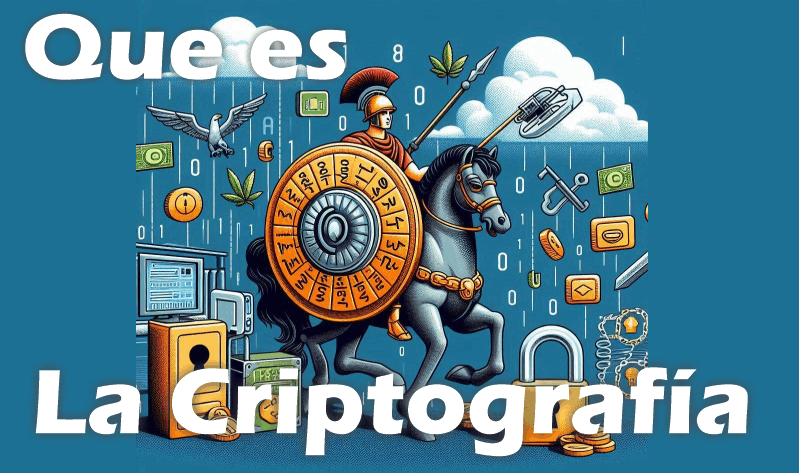What is cryptography and what is it for?
Imagine you have a diary where you write your most important secrets. You don't want anyone to read it, so you decide to write everything in a language that only you understand. That, in essence, is what cryptography does, but in the digital world.

What is Cryptography?
Cryptography is like a lock to protect information. It is a set of techniques that are used so that only authorized people can understand certain data. Instead of using a physical key, codes and mathematics are used (but don't worry, you don't need to know how to solve equations to understand it!).
History of Cryptography
1. Julius Caesar's Cipher
The famous Roman emperor Julius Caesar used a simple but effective method to send secret messages to his generals. He shifted each letter of the alphabet a fixed number of positions (for example, "A" became "D"). If someone intercepted the message, they would see something incomprehensible. This method is so well known that today it is called "Caesar Cipher". Although it is very basic compared to current systems, it was revolutionary in its time!
2. The Enigma Machine in World War II
During World War II, the Germans used a machine called Enigma to encode their military messages. It looked like a typewriter, but could generate thousands of possible combinations to encrypt messages.
The Allies worked hard to decipher it, and finally, a group led by mathematician Alan Turing managed to break the code. This was crucial to shorten the war and save millions of lives. Curiously, Turing's work also laid the foundations for modern computers.
3. Mary, Queen of Scots' Indecipherable Message
In the 16th century, Mary, Queen of Scots, was imprisoned for conspiring against Queen Elizabeth I of England. Mary exchanged coded messages with her allies to plan her escape. However, Elizabeth's spies managed to decipher one of the messages, revealing the plot. This led to Mary's execution. This case shows that even a poorly made cipher can be deadly.
4. The Navajos in World War II
During World War II, the United States used a unique cipher system: the Navajo language. The "code talkers" were Native Americans who used their language to transmit coded messages. The Navajo language was so complex and little known that the Japanese never managed to decipher it. This system played a key role in the Allies' victory in the Pacific.
5. The Zimmermann Telegram
During World War I, Germany sent a coded telegram to Mexico known as the Zimmermann Telegram. In it, they offered support to Mexico to recover lost territories in the United States if they entered the war on the German side. The British intercepted and deciphered the message, leading to the United States joining the war. An anecdote that shows how cryptography can change the course of history!
6. The Mystery of the Voynich Manuscript
The Voynich Manuscript is a book written more than 600 years ago in a language or code that no one has been able to decipher to this day. It contains illustrations of plants, diagrams, and texts that do not correspond to any known language. Some believe it is a cipher system, while others think it is an elaborate hoax. Whatever it is, it remains one of the greatest mysteries of cryptography.
7. Cryptography and Medieval Lovers
In the Middle Ages, some lovers used simple ciphers to send secret letters. For example, they replaced letters with symbols or numbers. Although these codes were easy to decipher, they served to prevent curious people from finding out about their feelings. Cryptography also has its romantic side!
8. The Masons' Pigpen Code
The Masons, a secret society, used a cipher called Pigpen. This system assigned geometric symbols to the letters of the alphabet. Although it was not very secure, it gave them a discreet way to communicate and maintain their aura of mystery.
How does it work?

Let's think of a simple example: a secret message. Suppose you want to tell your best friend: "The meeting is at 3 PM". But you don't want anyone else to know. With cryptography, you could transform the message into something like: "Xb wvdklzx xq x zlfw 3 RM". Your friend has the key to decipher it and understand the message. Without the key, anyone who sees it will think it's gibberish.
In the digital world, cryptography works in a similar way, but with computers that do all that work of transforming and protecting information.
What is it used for?
Cryptography is everywhere, even if you don't realize it. Here are some examples:
Protecting your passwords: When you log in to a social network or your email, your password is encrypted. This means that if someone tries to steal it, they will see something unreadable instead of your real password.
Making secure online purchases: When you buy something online, your payment is sent securely thanks to cryptography. This prevents hackers from intercepting your data.
Private messages: Applications like WhatsApp or Telegram use cryptography so that only you and the person you are talking to can read the messages.
Protecting sensitive data: Companies, governments, and hospitals use cryptography to protect confidential information such as medical data or state secrets.
Why is it important?
In a world where almost everything is connected to the internet, cryptography is like a silent superhero that protects us from digital villains. Without it, our conversations, purchases, and even our identity could be at risk.
A curious fact
Did you know that cryptography is not new? Thousands of years ago, the Egyptians and Romans already used simple forms of cryptography to send secret messages in war. So it's not just something modern, but also something with a lot of history!
In summary
Cryptography is the tool that keeps our information safe and private in a digital world. Although it may sound complicated, its mission is simple: to protect us. So the next time you use your phone or buy something online, you can thank cryptography for keeping everything safe.






